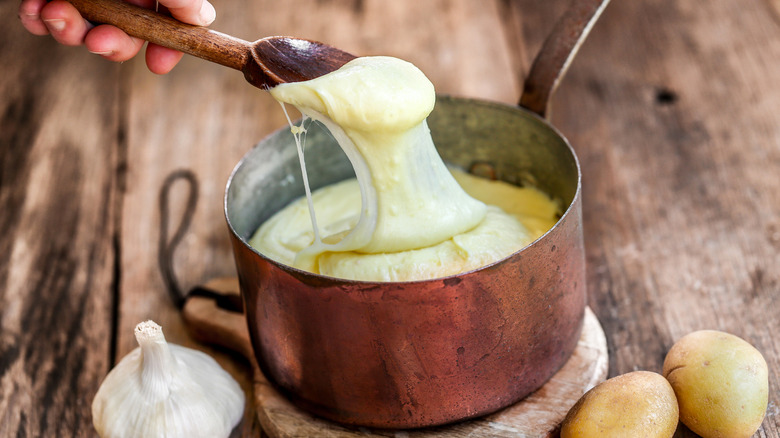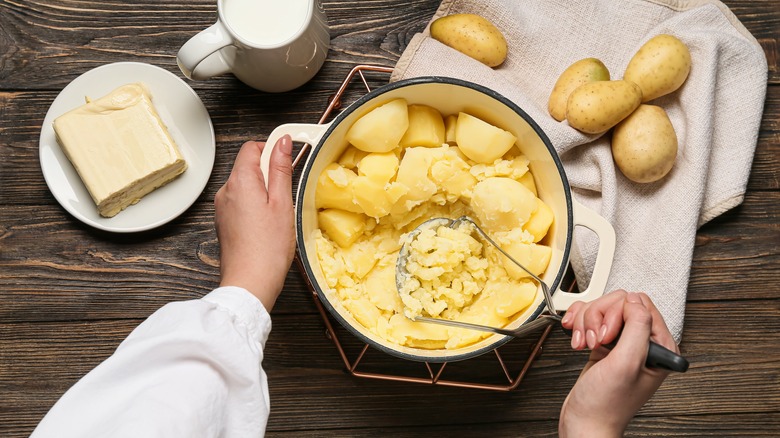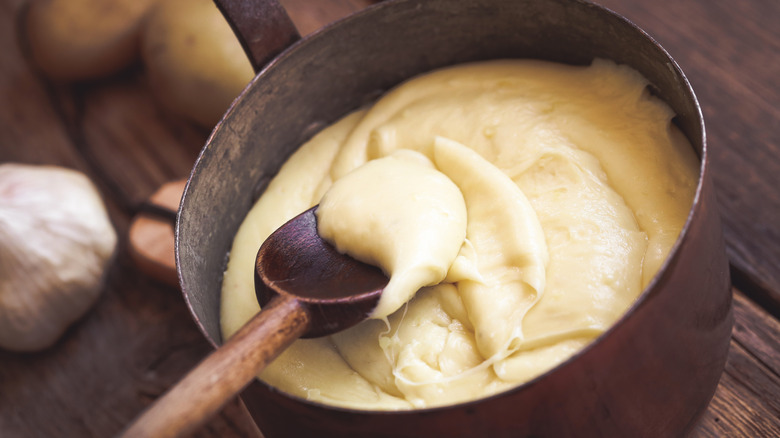French Pomme Aligot: Is It Cheese, Mashed Potatoes, Or Both?
Nothing gets engagement on social media quite like a good cheese pull. Whether it's a couple of simple strands between two pieces of a hot mozzarella stick or the outrageous gooey globs in this TikTok-famous fried sandwich tower that made Gordon Ramsay cringe, it's all about showing the stretchy strings of melted cheese to get your eyeballs eating.
If you can't get enough of #cheesepull, you're going to love French pomme aligot, the cheesy dish that was stretching way before it was cool. Aligot comes from the L'Aubrac region of central France and is made by mixing an unholy amount of fresh tomme or Cantal cheese into well-mashed potatoes and mixing them with cold butter and hot milk, then whipping them with a heavy hand until they have a gluey, stretchy texture.
Aligot is often confused with fondue because the texture looks pretty similar. Fondue, however, is comprised mostly of a blend of melted cheeses mixed with wine or spirits, while aligot is part cheese part mashed potatoes. Fondue is also served totally differently. You eat fondue by dipping pieces of bread, fruit, and vegetables or meat into a bubbling pot, while aligot is mostly served as a side with local sausages.
Aligot is mostly potatoes — and lots of cheese
Described by The New York Times as "somewhere between buttery mashed potatoes and pure melted cheese," aligot has become a bit of a cult-classic dish. Cheese pull aficionados went crazy for a viral video on Instagram in 2022 from an aligot competition in Laguiole, France, where local chefs competed to make the stretchiest stuff, some of them getting to almost 16 feet.
But keep in mind that while there's a lot of cheese involved, the base of aligot is really potatoes; most aligot recipes call for a ratio of around a pound of potatoes to a half pound or so of cheese. In fact, a lot of that signature stretch comes from potato starch.
Aligot is a recipe that's deceptively simple — there aren't a lot of ingredients, but you need to pay attention to technique. All you need is potatoes, fresh tomme, laguiole or cantal cheese, garlic, butter, and salt and pepper. Tomme isn't the easiest cheese to source in the U.S., so you can sub in some varieties that have similar melty/stretchy qualities to gruyère's. The experts seem to agree that it's important to make sure you get a fine mash on your spuds before mixing in the cheese, so try using a ricer or a food mill to get a fine, uniform texture. You could also use reheated leftover mashed potatoes — just make sure they're not clumpy.
Making aligot takes some extra elbow grease
Once you have your ingredients ready to assemble, aligot is a little more involved than making a simple batch of cheesy mashed potatoes. Remember that you've got a lot of cheese to melt, and you want the texture to resemble thick wallpaper glue. Once you have your potatoes and cream all mixed up in the pot on the stove or in a double boiler (aka bain marie), you'll need to vigorously mix everything for several minutes as you add the cheese in handfuls, letting it melt in between, until you develop the signature stretchy texture.
Traditionally, aligot mixing is done by hand, which is no small feat as it can take 10-20 minutes of hard stirring to get the perfect sheen. Local lore dictates that it also only be stirred in one direction. You can save your arm, however, by using an electric handheld mixer to do the grunt work. Just be sure to stop periodically and lift a bit out of the bowl to see how the texture is coming along.
As Larousse suggests, "Raise the wooden spoon higher and higher while mixing. When the dough is smooth, unctuous and stringy, the aligot is cooked." Once you're done, serve it with some homemade sausage to be extra traditional, and of course give it a stretch on your social media for your cheese-loving followers.


